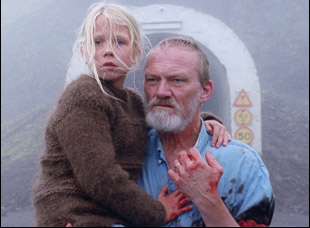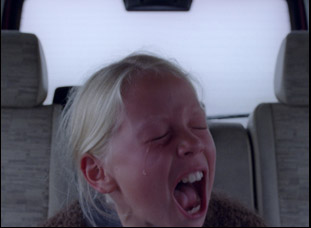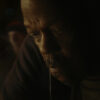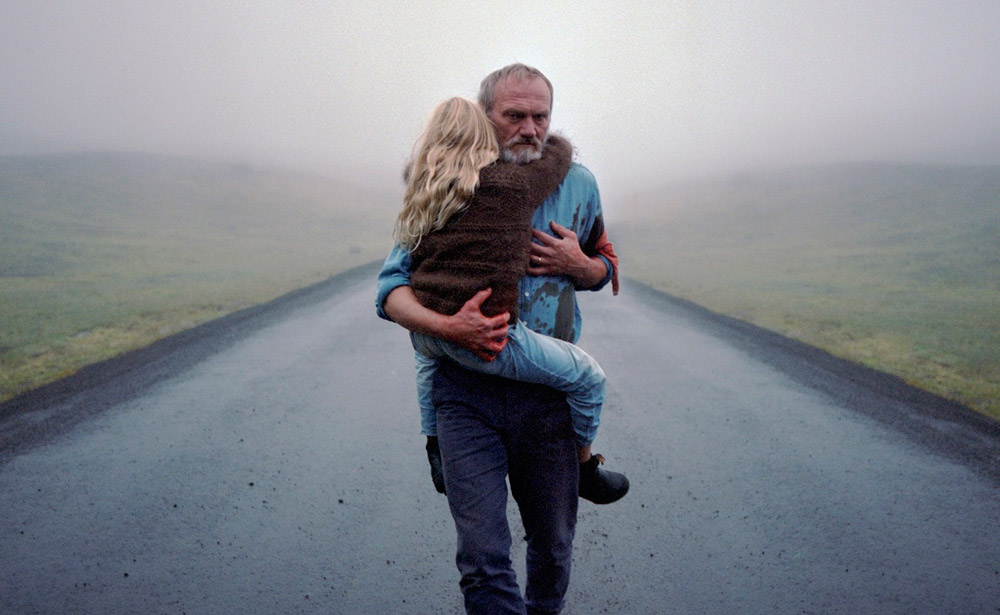“Kids don’t think about what adults or old people are doing,” the eight-year-old Salka (Ída Mekkín Hlynsdóttir) informs her grandfather Ingimundur (Ingvar Sigurdsson) in Hlynur Palmason’s “A White, White Day,” a blessing of sorts when he seems so consumed these days by adult matters. Still driving down to the police station from where he recently retired to have coffee, he is weathering two dramatic changes in his life when the end of his career coincided with the loss of his wife in a tragic car accident, lost in the thick fog that blankets the coast of Iceland. He spends the rest of his days building a house for Salka and her parents Elin and Stefan, an act of his deep love for them — well, not his son-in-law Stefan, exactly – to take his mind off how the rest of his world has fallen apart, particularly as he learns his wife was hiding certain things from him before her death.
“I was [interested in] exploring this story of two kinds of love – a relationship between a grandfather and a granddaughter, because that was a very important part of my life, but then I was also interested in another kind of love, that love is towards a lover, a relationship that is completely different and much more complex,” says Palmason, who finds the two competing in his tense second feature.
Told with the crackling energy of a slow burn thriller that’s continually teetering on the edge of exploding, “A White, White Day” considers how Ingimundur’s devotion can be seen in one respect as admirable and in another poisonous when it’s all-consuming, leaving him unable to prevent himself from contaminating the other relationships in his life when one goes so bad. Sigurdsson, a magnificently stoic presence who won the Rising Star Award at Cannes’ Critics Week sidebar where the film premiered last year, lets audiences in on his complete collapse, his greatest fears and insecurities seeping into the bedtime stories he tells Salka and his increasingly brusque manner around his friends at the force, and Palmason will often lurk around patiently with the camera as if watching a lion about seize on its prey, only Ingimundur seems intent on tearing himself apart from within.
With the film recently being made available through Film Movement’s Virtual Cinemas, which shares the proceeds of its rental fees with the arthouse of your choice while allowing you to watch the film from the safety of home, Palmason was kind enough to talk about the intricacies of making “A White, White Day,” including the film’s dependence on Iceland’s unmistakable weather patterns, casting his daughter as Ingimundur’s and how he was able to achieve such a visceral sense of memory without resorting to flashbacks.

Yeah, I’m always very drawn to certain places and when I go to these places, a story begins to slowly emerge. Without a location or without a space or a season, it’s very difficult for me to work, so I always try to go out and find the right places in the very early process of making a film.
You can tell because I imagine it took some time to film that opening montage where you can actually see the seasons change around the central location. How did you plan for that?
I was so focused on having that specific location I didn’t even have an agreement with the people owning it or the town, so I just started filming there without even having a permit for it. [laughs] They were not giving me what I wanted, but I filmed the opening scene over two years, and while filming it, I was forming the rest of the film, writing and researching and going to all the [other] locations.
Since it’s so engaged with the weather, did you plan it knowing what the conditions would be?
It’s a funny thing, the weather. Sometimes you get exactly what you dreamed of, but sometimes it surprises you and gives you something else. For example, the fog is real fog. It’s not a fog machine, so that was written for a specific location for a specific season, and that’s part of the prep for the film is having the scene for the right location, but it wasn’t always foggy, so we did do some waiting. But it worked in the end.
You’ve said you talked to Ingvar as early as 2013 about playing Ingimundur. Were you able to shape this film together over the years?
Yeah, “Winter Brothers” and “White, White Day” were both written for [specific] actors because I liked having someone that I know or that I’ve met and I can easily be in contact with. I’m always sending my actors images or poems or texts — I don’t know if it represents [anything], but it connects to the character. I’m not very fond of talking about backstories or anything like that. For me, it’s okay that it’s mysterious and I’m just trying to find some kind of humanity in it. So I wrote this film for Ingvar and my daughter Ída, and [Ingvar and I] started very early – 2013, I think I asked him if he was interested, just [after] working on a short film I made and we really bonded and really worked well together.
Your daughter Ída is just extraordinary in this. At what point did you want to involve her?
Ída and I had been working a lot together, ever since she was born actually. We’ve always been playing around and making small video work and she’s just always been a big part of my process, so this seemed like a very natural step. I did ask her and she was very interested in it, and I don’t think I would’ve asked her if I didn’t know she was fond of [acting]. But I have a really solid crew — I’m surrounded by family and friends — so I felt it was a very good environment to make a film and invite her into the process.

Yeah, I’m always searching for some kind of reaction or movement or something you can only capture once and not again, so we always prepare scenes like that where we try to capture a a state of grace or magic. Sometimes you get it in take 40 and in some scenes, it’s about the reaction, so you only get it in the first take, and [Ída’s] reaction in the bedtime story was the first time we did it. I remember screaming when the scene was done. [laughs] I told everybody to get out of the house and go home. “We’re done for today and just let’s stop. This was great.” It was fun.
The film has such an unusual and compelling rhythm to it, something that must’ve been figured out before you started shooting since there’s a lot of long takes. How did you figure it out?
Yeah, it’s interesting you say rhythm because I agree — a film for me is very much rhythm and it’s almost like a composition and a movement and that very much starts while I’m writing the script. I try to work on the rhythm a lot while I’m writing, so in the final stages of writing, I always put the whole film in a large room and I go through it and I try to see if the rhythm is right. Of course, this changes and you reinvent the rhythm in the editing, and I have a really good collaboration with my editor.
How you introduce memory in the film is fascinating since you don’t resort to flashbacks.
It was very important for me that the woman he loved is present in the film, but like you say not in the sense of seeing flashbacks. I’ve never experienced a flashback myself and I wanted to avoid that, so I tried to express her through her objects and the things she had, like for example the things in the box or how her shirt smelled, or videos – very practical things that are materialized that can capture a person or at least create an image in the audience’s head so they can put their own things into it.
It has a real tactility throughout, in part because it’s shot on 35mm. What drew you to that as a format for the film?
There was a lot of things.“Winter Brothers,” the film I made before, was shot on 16mm and I knew I wanted a different look and a different texture. I wanted the [central] figure to work within a landscape and I don’t think 16 is large enough a format for a landscape. It’s very good at intimacy and skin and movement, but it lacks when you have a larger image and a small figure in a landscape. So we were testing, and the prologue was shot actually on 4-Perf anamorphic, so it was a very large format, but then when we got into production and preparing the more traditional scenes Maria, my cinematographer, and I discovered that the scenes actually worked better if we shot it with spherical lenses — 2-Perf Super 35, so it was a lot of testing just trying to simplify it and make it work.
What’s the last been like traveling with the film?
It’s really been wonderful and it’s been very emotional [which] is not surprising, but a film is something you hold quite dear. There’s a lot of work, a lot of collaboration and a lot of time and I’m just happy to see that the world is interested in it. You never know if it’s going to work or not and it’s up to the people, so I was pleasantly surprised and very happy.
“A White, White Day” is now available to stream at home through Film Movement’s Virtual Cinema with some of the proceeds benefiting your local arthouse theater.




